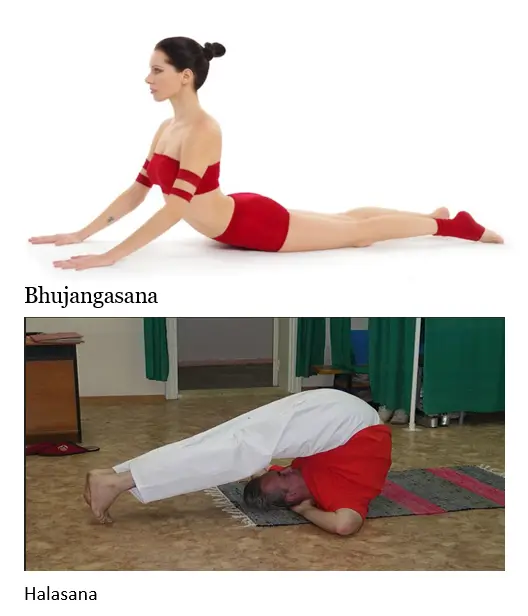Exploring Halasana (Plow Pose) and Bhujangasana (Cobra Pose)
In the world of yoga, asanas (Sanskrit for postures) offer a gateway to a healthier mind and body. Today, we delve into two powerful asanas: Halasana (Plow Pose) and Bhujangasana (Cobra Pose). Both poses, though seemingly opposite, provide a beautiful balance of stretches and invigorating energy.
Do not try these without a professional help, this information is to provide you an awareness.
Here are some important precautions to take while performing asanas:
- Listen to your body: This is the most important rule. Yoga is about finding a comfortable stretch, not pushing yourself to the point of pain. If something hurts, come out of the pose.
- Don’t force it: Never force your body into a position it’s not ready for. Asanas should be entered and exited smoothly and with control.
- Warm up: Always do a light warm-up before practicing asanas. This will help to prepare your muscles for movement and reduce the risk of injury.
- Be mindful of your breath: Breath is an essential part of yoga. Focus on slow, deep breaths throughout your practice.
- Start slow and progress gradually: Don’t try to jump into advanced poses right away. Begin with beginner-friendly asanas and gradually increase the difficulty as you become more comfortable.
- Know your limitations: If you have any injuries or medical conditions, be sure to talk to your doctor before starting yoga. There may be certain asanas that you need to avoid.
- Practice on an empty stomach: Ideally, you should practice yoga on an empty stomach, or at least 2-3 hours after a meal.
- Use a supportive mat: A yoga mat with good grip will help to prevent you from slipping and sliding.
- Find a qualified instructor: If you’re new to yoga, it’s a good idea to find a qualified instructor who can teach you proper alignment and technique.
By following these precautions, you can help to ensure that your yoga practice is safe and enjoyable.
Halasana (Plow Pose): A Calming Inversion
Halasana, also known as Plow Pose, is a gentle inversion that promotes relaxation and improves digestion. Here’s how to perform it:
- Begin by lying on your back. Extend your legs together and rest your arms by your side.
- Engage your core. Inhale and raise your legs towards the ceiling, keeping them straight.
- Support your lower back. Use your hands on your lower back (above the buttocks) for support as you lift your hips off the ground.
- Gently walk your feet overhead. Slowly lower your legs over your head until your toes touch the floor behind you.
- Maintain a steady breath. Hold the pose for 5-10 breaths, focusing on your deep, diaphragmatic breathing.
- To exit the pose, exhale and slowly lower your legs back down to the starting position.
Benefits of Halasana:
- Stress reduction: Halasana is known to calm the mind and alleviate anxiety.
- Improved digestion: The inverted position can aid digestion and elimination.
- Strengthens core: Engaging your core muscles is crucial for maintaining the pose.
- Increased flexibility: Halasana stretches the hamstrings, shoulders, and spine.
Bhujangasana (Cobra Pose): Energizing Backbend
Bhujangasana, or Cobra Pose, is a powerful backbend that strengthens the spine, improves posture, and energizes the body. Here’s how to get into Cobra Pose:
- Lie on your stomach. Keep your legs together and your feet flexed.
- Place your palms flat on the floor beside your shoulders. Elbows tucked close to your body.
- Engage your core. Inhale and press your palms into the mat, lifting your upper torso off the ground.
- Lengthen your spine. Arch your back gently, keeping your gaze slightly upwards.
- Maintain a steady breath. Hold the pose for 5-10 breaths, focusing on your deep breathing.
- To exit the pose, exhale and slowly lower your torso back down to the starting position.
Benefits of Bhujangasana:
- Strengthens the spine: Cobra Pose strengthens the back muscles and improves spinal flexibility.
- Improves posture: The backbend helps to correct hunching and promotes proper posture.
- Energizes the body: Bhujangasana stimulates the internal organs and leaves you feeling invigorated.
- Opens the chest: This pose stretches the chest muscles, improving lung capacity.
Finding Balance: Combining Halasana and Bhujangasana
Halasana and Bhujangasana offer a beautiful counterbalance to each other in your yoga practice. The calming inversion of Halasana prepares the body for the energizing backbend of Bhujangasana.
Remember:
- It’s important to listen to your body and modify the poses as needed.
- If you have any injuries or pre-existing conditions, consult with a doctor or yoga therapist before practicing these asanas.
With consistent practice, Halasana and Bhujangasana can become powerful tools for unwinding, energizing, and bringing more balance to your yoga journey.
Image credit
AKA MBG, Public domain, via Wikimedia Commons

